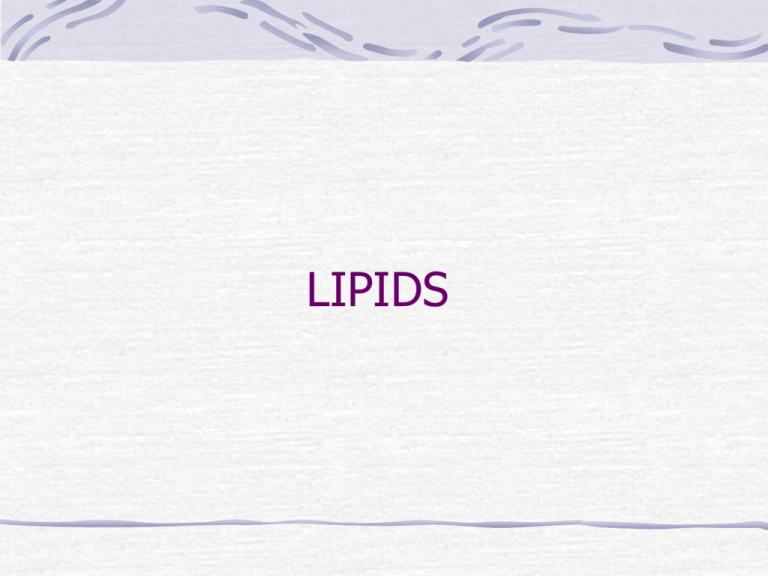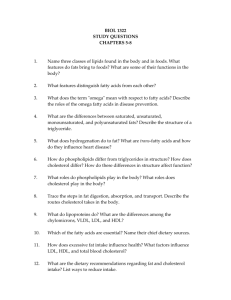lipids ppt - gozips.uakron.edu
advertisement

LIPIDS THE LIPID FAMILY ORGANIC COMPOUNDS INSOLUBLE IN WATER INCLUDE: TRIGLYCERIDES PHOSPHOLIPIDS STEROLS TRIGLYCERIDES GLYCEROL BACKBONE (CHO) GLUCOSE ALL ALIKE –”BACKBONE” OF TRIGLYCERIDE FATTY ACIDS ENERGY (BETA OXIDATION) GLYCEROL BACKBONE CONDENSATION – GLYCEROL AND FATTY ACIDS MIXED TRIGLYCERIDE FATTY ACIDS Organic acids – chains of carbon and hydrogen Acid group – COOH Methyl group – CH3 PROPERTIES OF FATTY ACIDS CHAIN LENGTH Most are even number of carbons Short chain = 4-6 carbons; milk, butter Medium chain = 8-12 carbons; coconut oil and synthetic medium chain triglycerides Long chain = 14-30 carbons with 16-18 most common; animal and plant sources SATURATION Saturated Mono-unsaturated Polyunsaturated Affects physical state – liquid or solid Biological effect COMPARISON OF DIETARY FATS ESSENTIAL FATTY ACIDS Body cannot manufacture – necessary for body functions Conditionally essential – inadequate precursors Need 4% of Kcals from EFA Lack of: skin irritation dehydration growth failure infections liver changes visual problems ESSENTIAL FATTY ACIDS OMEGA-6Linoleic (18:2n6) found in vegetable oils *Arachidonic (20:4n6) from linoleic, egg yolk, beef liver OMEGA-3 Linolenic (18:3n3) found in leafy vegetables * EPA and *DHA Eicosapentaenoic Acid Docosahexaenoic Acid from linolenic, fish, seafood OMEGA FATTY ACIDS BENEFITS OF EPA & DHA Lowers serum cholesterol and triglycerides Lowers tendency for blood to clot EPA regulates blood pressure Increases synthesis of immune substances Recommend – fish 2 times/week No fish oil capsules OMEGA-3 FATTY ACIDS IN FISH Fish 3.5oz raw Omega-3 Cholesterol Mackeral, Atlantic 2500 mg 80 Herring, Atlantic 1600 60 Bluefish 1200 59 Salmon, Atlantic 1200 74 Tuna, white 500 47 Tuna, light 250 47 Cod, Atlantic 300 43 Shrimp 300 42 Flounder 200 46 Haddock 200 63 Sword Fish 200 39 MEDIUM CHAIN FATTY ACIDS MCT = Medium Chain Triglycerides Synthetic fats and fatty acids (8-10 carbons) Used with poor digestion and malabsorption Easily digested by intestinal lipase Absorbed without bile acids Transport portal vein liver without being resynthesized to triglycerides Used in some enteral formulas Not palatable PHOSPOLIPIDS Glycerol backbone Two fatty acids Phosphorus containing unit in place of 3rd fatty acid Important part of cell membrane constituents Water soluble and fat soluble Fatty acids move across lipid membranes into watery fluids Allow fat soluble substances to pass in and out of cells PHOSPHOLIPID STRUCTURE PHOSPHOLIPIDLECITHIN PHOSPHOLIPIDS Found naturally abundant Eggs, liver, soybeans, wheat germ, peanuts Used as emulsifiers Food processing Body – keep other fats suspended in blood Should be ~ 5% of lipids in diet WATCH HEALTH CLAIMS - LECITHIN STEROLS - CHOLESTEROL Composed of C, H, O atoms Arranged in rings Variety of side chains Present in ALL animal fats, NOT vegetable, plant fats Sources: Dietary (300-500 mg/ day) Liver manufactures 600-1500 mg/day CHOLESTEROL CHOLESTEROL Necessary for formation of essential substances: * steroid hormones * bile salts * cell membranes * myelin * vit D sythesis * adrenal hormones Dietary cholesterol is NOT a significant contributor to serum cholesterol More important Saturated Fatty Acids and Total fat Fat Digestion FAT ABSORPTION Glycerol Short & Medium Chain Fatty Acids Absorbed into blood at portal vein to liver Monoglycerides & Micelles (Intestinal wall) Long Chain Fatty Acids Reassembled into TRIGLYCERIDES EMULSIFICATION OF FAT HYDROLYSIS ABSORPTION Triglycerides + Cholesterol + Phospholipids + Proteins = LIPOPROTEINS TYPICAL LIPOPROTEIN LIPOPROTEINS Transport lipids Blood lipid profile Made in liver and small intestine Made of triglycerides, phospholipids, cholesterol, protein water solubility CHYLOMICRON From dietary fat Intestinal cell wall Transports lipids to muscle and fat cells broken down by lipoprotein lipase Remnants to the liver to be dismantled VLDL – VERY LOW DENSITY LIPOPROTEINS Lipoprotein synthesized by liver Triglycerides, cholesterol made from nondietary sources (endogenous), carbohydrates, proteins, fats Greatest percent of lipids triglycerides LDL-LOW DENSITY LIPOPROTEIN Remnant of VLDL – triglycerides pulled out More dense than VLDL Less lipids but more cholesterol Separated to build hormones, cell walls, smooth muscles Gathers cholesterol from lipoproteins and bloodstream deposits body cell Plaque formation arterial wall Removed from circulation by liver HDL-HIGH DENSITY LIPOPROTEIN Scavenger of cholesterol – removes from arterial walls Competes with LDL for receptor sites to prevent plaque formation Liver makes HDL to transport Cholesterol and phospholipids made by cells back to liver for recycling or disposal LDL/HDL ratio important in heart disease LIPOPROTEINS COMPARED TYPES OF CHOLESTEROL HOW TO HAVE A HEART ATTACK CORONARY RISK FACTORS MODIFIABLE Hypercholesterolemia Hypertension Smoking Physical Inactivity Diabetes Mellitus Low LDL Obesity FIXED Family history Age Gender Menopausal females without hormonal replacement HEART DISEASE High LDL Low HDL HDL-LDL RATIO Total Fat Intake Lab Goals: Total Cholesterol = <200 mg/dl Triglycerides = <150mg/dl LDL = <130 mg/dl ^ risk >160 HDL = >60 mg/dl ^ risk < 35 LDL/HDL ratio <3.0 (Best 2.5) 160/35 = 4.5 ^ risk 130/60 = 2.1 low risk HDL:LDL RATIO ATHEROSCLEROSIS LIPID PROFILE WHERE FAT IS AT! Middle increased risk of ^ blood pressure, DM, ^ serum cholesterol, ^ CVD “Apple shape” – Android (male) Arms, thighs, buttocks lower risk, “Pear shape” – Gynecoid (female) “Pear shape” more desirable than “apple” WHERE FAT IS Waist:Hip ratio At risk for obesity related problems if women >0.8 men > 0.95 Waist: Hip ratio is waist circumference divided by hip circumference in either inches or centimeters STEP DIETS NCEP-National Cholesterol Education Program Age 20 and abovetotal chol & HDL every 5 years: IF total Chol >240mg/dl and evidence of CHD Check LDL IF total Chol = 200-239mg/dl & HDL <35mg/dl Before drug therapy – for 6 months * decrease saturated fat * decrease cholesterol intake * adjust weight (decrease caloric intake & increase physical activity Post menopausal HRT to decrease LDL STEP DIETS STEP 1 STEP 2 TOTAL FAT < 30% Kcals Same SFA <10% Kcals <7% PUFA Max 10 Kcals Same MUFA Remaining fat calories Same CHOL < 300 mg daily < 200 CHO 55% Kcals Same PROTEIN 15-20% Kcals Same KCALS Achieve and maintain IBW Same Promote normal growth and development Same DRUG THERAPY FOR HYPERLIPIDEMIA Should be 6 months after diet therapy Bile Acid Sequestrants (cholestyramine, colestipol) Causes binding of bile acid in gut Liver pulls more cholesterol to manufacture more bile Nicotinic Acid dec VLDLdec LDL, TG, ^ HDL Probucol (Lorelco) - ^ LDL excretion, Genfibrozil (Lopid) – dec TG, ^ HDL, dec LDL Lovastatin (Mevacor) – dec Chol synthesis, dec LDL FAT FUNCTIONS BODY Provides energy – 9 kcals/gram Insulates Protects organs (shock absorber) DIET Fat soluble vitamins Flavor, aroma, tenderness Slows digestion, satiety, fullness FAT AS ENERGY ADIPOSE CELL Adipose cells have lipoproteinlipase (LPL) on surface to extract triglycerides LPL hydrolyzes Triglycerides and directs components into cell for metabolism and storage ADIPOSE CELL FOR ENERGY Hormone sensitive lipase dismantles stored triglycerides glycerol and fatty acids Cells requiring energy break down fatty acids energy + CO2 + H2O Needs CHOs to completely metabolize Does NOT provide enough energy for brain or CNS Without CHO: Fat + fat = ketone bodies (ketosis) HYDROGENATION Polyunsaturated saturated fat Liquid solid Add hydrogen at the double bond Does not change Kcals or cholesterol Decreases rancidity: double bonds break (unstable) spoilage CIS to TRANS fatty HYDROGENATION CIS TO TRANS HYDROGENATION CIS Formation Typical of fatty acids found in natural foods Hydrogens on same side U-like formation TRANS formation During hydrogenation Hydrogens on opposite sides Linear formation Safety issues - LDL= Saturated fat diet ( HDL) FAT SUBSTITUTES Proteinamino acidsmetabolized egg whites, milk protein, or whey protein concentrate CHO derivativeshydrolysissimpler form oat bran (amylase)amylodextrin (dextrinase)glucose Olestra 3 chain fatty acidHepta, hexa, & octaesters OLEAN STRUCTURE FAT SUBSTITUTES









